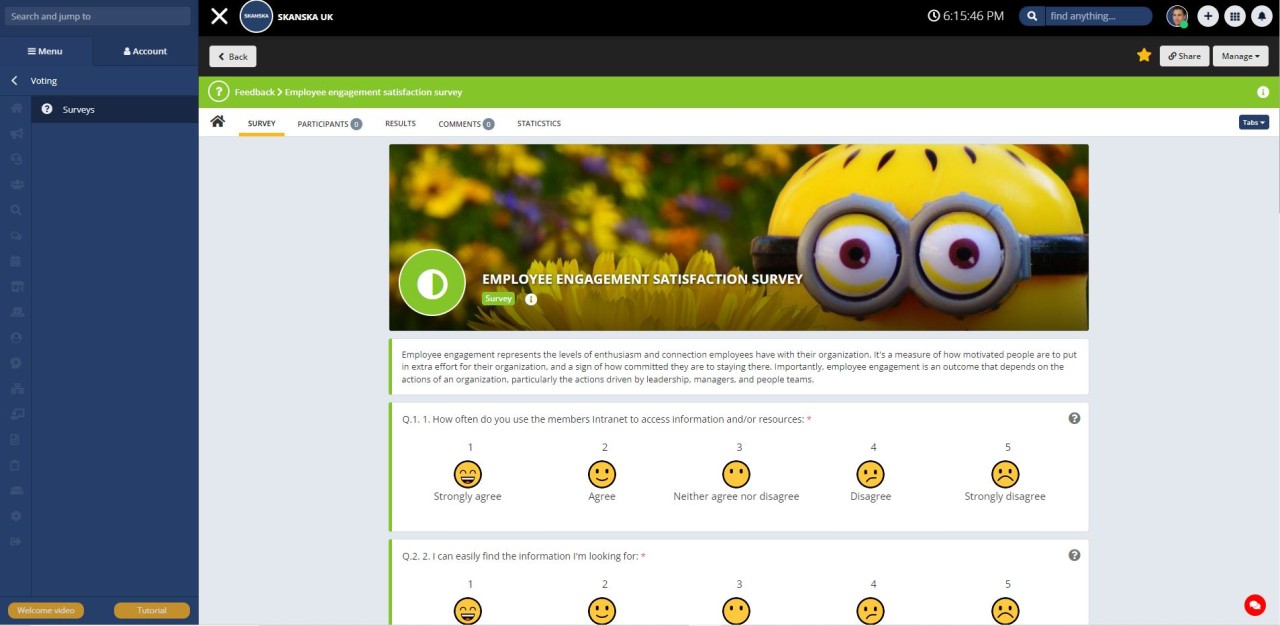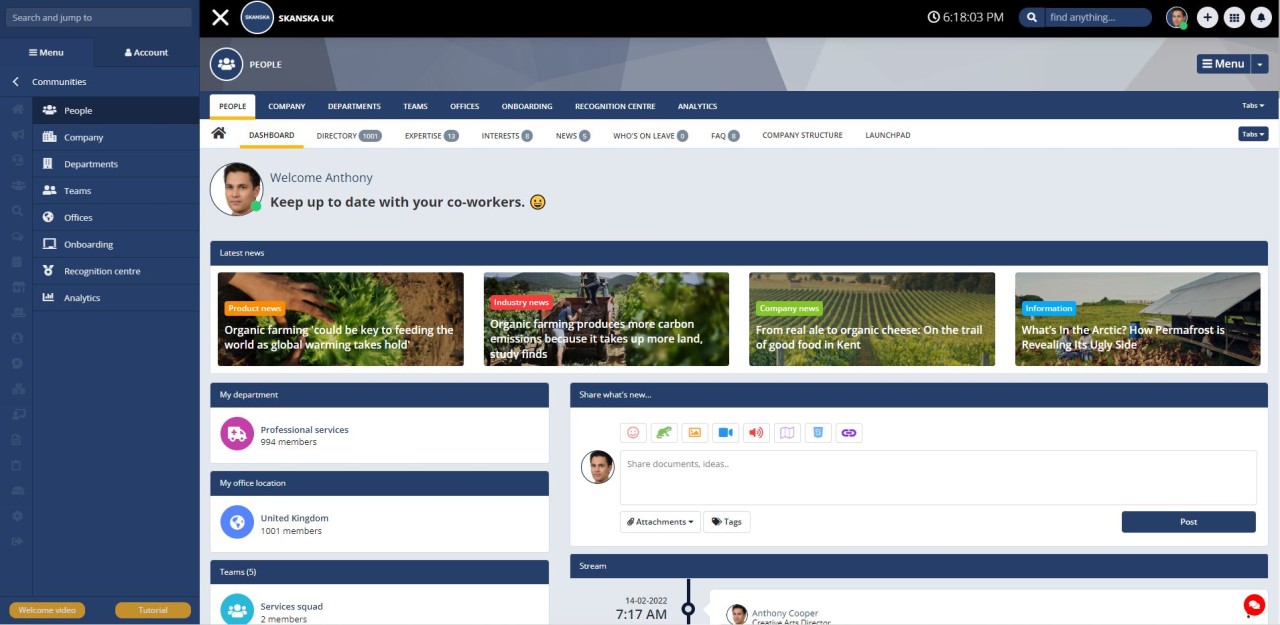Insight Blog
Agility’s perspectives on transforming the employee's experience throughout remote transformation using connected enterprise tools.
9 minutes reading time
(1738 words)
Most effective ways to enhance employee satisfaction in 2022
Employee satisfaction surveys primarily exist to outline employees' problems so that the managers can act upon them and provide employees with the ideal working conditions to boost their productivity.
Employees make or break the success of any company. In today's business world, employee retention, productivity, and engagement are the most pressing issues, and developing strategies to improve and build job happiness for employees must be a key priority.
It's a myth that higher pay leads to greater work satisfaction. In reality, research by Glassdoor in June 2015 found that for every 10 percent increase in pay, employees were just 1 point happier. Instead, the study found that a company's culture, beliefs, and possibilities for advancement go far beyond its pay structure. What practical initiatives can managers, HR reps, and leaders take to improve employee happiness and morale?
Employee satisfaction surveys primarily exist to outline employees' problems so that the managers can act upon them and provide employees with the ideal working conditions to boost their productivity.
Why focus on employee satisfaction?
In fact, a study conducted by Gallup also states that businesses with engaged employees deliver 50% higher sales, 50% higher customer loyalty, and 38% above average productivity.
It is critical for employees to be happy and to perform at their highest level if they are not satisfied with their jobs. Employees who feel happy at the workplace are more likely to remain loyal to the company, even if things go wrong. No one feels motivated due to a sense of duty but rather by a desire to take their organization to the next level.
Employees may only be passionate about their work if they are happy with their position within the firm as a whole. A positive work environment is created when employees are happy. People are less likely to complain and more focused on their jobs. Moreover, an engaged workplace can reduce employee absenteeism.
A lot of resources are lost each year due to employee turnover.
Employees can leave if you don't get their feedback and apply it. Instead of being able to make adjustments for the new workers, you'll find yourself in a revolving door of turnover and losing money that may be put to better use elsewhere.
About 21 percent greater profit is generated by companies with a high level of employee engagement. It's a fact: contented workers are more productive. Conducting employee surveys on a regular basis can provide you with useful information that can be used to develop a new product or enhance an existing procedure.
Why is flexibility key?
- Allowing workers to take greater responsibility and control over their own time is essential. Flexible work schedules and the possibility to telecommute based on individual needs are important initial steps for you if you want to attract and retain top talent. The stress of the daily drive can be alleviated by allowing employees to come and go as they choose!
- Flexibility is an important tool in problem-solving. Projects with many moving parts are more manageable when working with flexible team members whose skill sets overlap, and being adaptable to sudden changes means you can react to new conditions without slowing down or becoming stressed.
- An ability to reshape your role within a team so that you can more easily meet your objectives means you can evolve and grow alongside your company, no matter your job description. Flexibility in business is an asset to most employers, and workers who readily demonstrate their ability to intelligently respond to a changing environment are highly valued.
Should employees take ownership?
- 3 things to focus on when it comes to allowing employees to take their role to another level, ownership, having a culture of accountability, and having a high trust workplace.
- We understand employee ownership when we believe that taking action is not someone else's responsibility and this is something we need to drill in our employees.
- Allow employees to take ownership tells others — "You can trust them to do the right thing". That encourages employees to take ownership in the workplace to excel and build a culture of ownership.
- People who are able to choose their own roles and use their abilities in the workplace report higher levels of job satisfaction.
- However, managers must use discretion in balancing an employee's wishes with the demands of the organization while conducting regular performance reviews that provide an opportunity for feedback and promote a proactive approach to role growth.
It is time to stop micromanaging
- Ensure that middle management is able to strike a delicate balance between assisting their teams and micromanaging.
- Anecdotal evidence suggests that managers who are unable to delegate and who exert their authority at will because they "can" produce an environment of low morale, lack of innovation, disengagement, and high staff turnover because they are unable to delegate effectively.
Offer incentives and extras
- There must be a sense of appreciation for the effort and performance of each employee.
- Make use of methods for recognizing employees' efforts, such as company-wide intranet announcements, internal newsletters, or gatherings of employees.
- Your employees may appreciate minor but meaningful incentives, such as extra vacation days, a day off, a lie-in, ad-hoc gifts, or the use of the best parking space for the month. Set challenging but attainable goals that your staff may work toward.
Improving communication and openness should be a priority
- The most disgruntled workers are those who believe they were not kept aware of changes in the workplace when they occur.
- As a result, employees become disengaged, and dangerous behavior known as "Chinese whispers" develops among them.
- Employees need to be informed in a way that is open and honest. Make sure your employees are up to date on corporate news by utilizing intranet software, company e-mails and newsletters, management cascade meetings, and 'town hall' announcements.
- Allow communication as it can help to foster a collaborative environment where employees can express their ideas and concerns without fear of being ignored.
Encourage your employees to participate in team-building exercises
- Team building is an important part of taking care of the atmosphere in the organization. As research shows, companies and startups which regularly conduct team-building meetings have seen an increase in employees' productivity.
- But not every subordinate wants to participate in that kind of integration activity.
- About 33% of employees believe that collaborating with coworkers makes them more devoted to their employer. You may improve communication and develop a better working community by participating in team-building activities both within and outside of the workplace.
- Don't forget to encourage breaks for your employees in addition to organizing get-togethers. As a bonus, they'll be able to form relationships with their coworkers as they recover.
Consider the requirements of your employees
- Understanding your employee as a person, rather than just their work-related skills and flaws, is crucial.
- You can do it through multiple means in which this will benefit you, including a better understanding of their feedback and what responsibilities they are capable of taking on.
- Flexibility in scheduling, casual Fridays, and other company policies are all examples of things you might want to consider implementing.
- Individual employee needs can be discovered, and a smoother workplace can be created.
Enhance the working atmosphere
- It's the little things that count. Substandard facilities and annoyance caused by slow servers, insufficient software, or malfunctioning equipment are more likely to lead to employee dissatisfaction than better facilities.
- Respond quickly to employee complaints and provide reporting mechanisms to discover problems.
- Employees will be more engaged and enjoy going to work if the office has additional personal modifications, such as pictures on the walls or a large-scale Google slide.
- Allowing employees to take ownership of their own workspace and add tiny, personal touches can bring positivity and increase happiness in the workplace.
Provide training to your employees
- As a manager, encourage your staff to strive for more and help them build their careers.
- Training, upskilling, mentoring, or coaching employees has proven to increase their level of happiness and involvement with the company.
- Not only will your organization's employees be more productive when they are content, but they will be able to contribute more as a result.
Improve the company's culture as a whole
- Gallup reports that intimate connections at work boost employee satisfaction by up to 50%.
- Employers can assist in the establishment of strong business culture by promoting socialization and communication inside the workplace.
- One crucial factor in reaching this goal is the use of intranet software that incorporates social capabilities and promotes cooperation, which is increasingly common as the world's workforce becomes more decentralized. The ability of coworkers to communicate and exchange ideas should be considered.
- Organizations that encourage their employees to participate in social events outside of business hours show better engagement and satisfaction at work.
Try to reduce bureaucracy in your organization
- Complex organizational hierarchies are typically associated with bureaucracy, which is defined as a concentration of administrative power in which rules and processes are clearly established. It is true that bureaucracy can be an effective way to manage company resources. However, this propensity can be mitigated by employing management approaches that focus on enhancing customer focus.
- Projects can be used to change bureaucratic structures. These temporary project units are created and managed by a company, which provides them with the necessary resources to accomplish their goals. Ad hoc teams made up of individuals with specialized training and experience can carry out specific activities or address specific issues as part of a project, which is overseen by a project manager. In general, project structures are better able to cut through organizational bureaucracy than functional departments.
Conclusion
Workplaces with more contented workers are more productive, creative, and innovative. Incorporating even simple adjustments to boost employee satisfaction can reap major long-term benefits for organizations. It is the perfect time for you to examine what you can do for your employees. The COVID-19 has made it clear that employee satisfaction is necessary, and employee intranet platforms like AgilityPortal are introducing innovative features to keep employees engaged and satisfied at office-based or remote workplaces.
Categories
Blog
(2576)
Business Management
(315)
Employee Engagement
(204)
Digital Transformation
(171)
Intranets
(119)
Growth
(116)
Remote Work
(61)
Sales
(48)
Collaboration
(37)
Culture
(29)
Project management
(29)
Customer Experience
(26)
Knowledge Management
(21)
Leadership
(20)
Comparisons
(5)
Ready to learn more? 👍
One platform to optimize, manage and track all of your teams. Your new digital workplace is a click away. 🚀
Free for 14 days, no credit card required.














